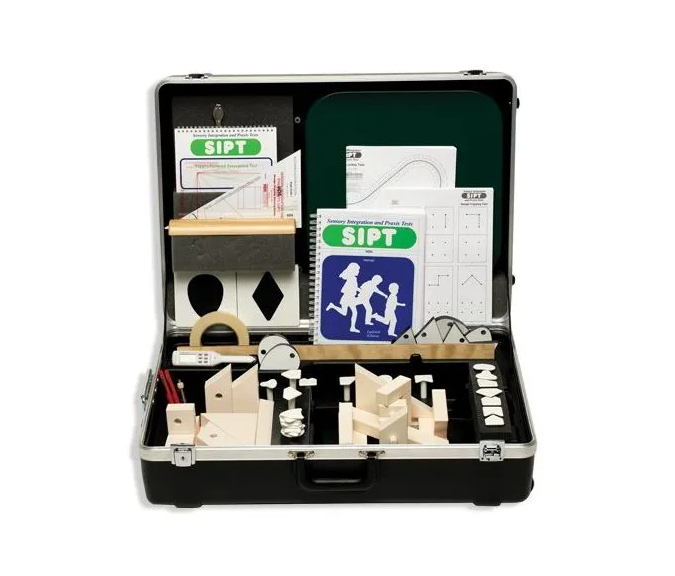Although not yet recognized in the DSM-V, Sensory Processing Disorder can be identified and categorized by an occupational therapist with advanced training in sensory processing and integration. Of primary importance is linking sensory impairments to challenges in functioning at home or school.
Identification usually begins with screening, which is basically a professional’s search for red flags that indicate enough differences in development to warrant a more comprehensive assessment.
Screening may take place at school, in your doctor’s office, or at a private practice clinic. Wherever it occurs, you are likely to be asked to fill out one or more parent checklists and developmental histories to supplement the observations of the evaluators.
If differences exist that are sufficient to warrant further assessment, the evaluation will follow. An evaluation for SPD involves standardized testing, detailed clinical observations, and parent-report measures.
If a multi-disciplinary team is involved, the evaluative process may also include a general health and physical evaluation, speech/language evaluation, psychological evaluation, and possibly referral to medical or other specialists if a specific problem area is identified.
Standardized assessment tools

A standardized assessment allows the comparison of a child’s functioning to a normative sample. These assessment procedures are particularly helpful when qualifying a child for services, obtaining a baseline of current functioning, determining strengths and weaknesses and establishing an initial treatment plan.
Currently, there is no gold standard assessment tool for diagnosing all 6 subtypes of Sensory Processing Disorder. There are many evaluation tools available that can provide enough information about a child’s sensory and motor development in order to make a determination of SPD. The most commonly used assessments include:
- Sensory Integration and Praxis Tests (SIPT)
- Miller Function and Participation Scales (MFUN)
- Bruininks-Oseretsky Test of Motor Proficiency™—Second Edition
- Movement Assessment Battery for Children – Second Edition (Movement ABC-2)
- Miller Assessment for Preschoolers (MAP)
- Goal Oriented Assessment of Life Skills (GOAL)

Other standardized tools are used to supplement the evaluation of sensory and motor processing for children with language challenges or difficulties in social-emotional functioning.
The Sensory Profile, Short Sensory Profile, and/or Sensory Processing Measure are screening that is often completed by parents or teachers. These scales are report measures and therefore should not be considered a complete assessment; they only screen for indications that a comprehensive evaluation is needed.
In addition to standardized assessment, all OT evaluations should include detailed observations in a clinical setting to determine strengths and weaknesses in a more ‘real-life’ situation. Sensory modulation challenges (e.g. responsivity to sensory experiences) can also be observed that may be impacting participation in daily life activities and routines. Most also include a thorough interview with parents and/or teachers.
The arguments for early diagnosis are strong, but don’t worry if you are the parent of an older child or an adult! A correct diagnosis of SPD fosters understanding at any age, even in adulthood, and many elementary school children, adolescents, and adults benefit from occupational or other therapy after diagnosis later in life.
If you spot the red flags of SPD in your infant or toddler, the case for seeking immediate diagnostic services is powerful.

Early diagnosis leads to early intervention. The sooner an accurate diagnosis is made, the sooner intervention can begin. Many children and their families suffer needlessly for years because of sensory issues that could have been addressed if a sound, the professional evaluation had determined that Sensory Processing Disorder was present and treatment had begun sooner.
Early diagnosis increases the chances of successful intervention. The immature brains of younger children are more “plastic,” which enables them to change more easily. This makes intervention more effective for them. Older children still benefit but the benefits may take longer to achieve and may be based on cultivating coping skills rather than on modifying the brain, as early intervention is believed to do.
Early diagnosis lays the groundwork for better school experiences. Children who receive intervention at younger ages–as infants or preschoolers–acquire the skills they will need to succeed in school sooner and usually have better experiences once they enter school. This is why federal law requires and funds the screening and, if indicated by the screening, multidisciplinary assessment of preschool-aged children with suspected disabilities.
Early diagnosis can prevent secondary problems from developing. Children who perceive themselves as “failing” at activities that most children perform effortlessly are at risk for other problems such as social difficulties, academic underachievement, acting-out behaviors, and/or low self-esteem and self-confidence. When children are diagnosed and treated at younger ages, they are more likely to escape this defeating cycle.

Early diagnosis provides correct labeling for unusual behaviors. Because of their atypical behaviors, children with SPD often attract negative labels such as “aggressive,” “withdrawn,” “weird,” “hyper,” “out of it,” and others from peers and adults. With early diagnosis, these behaviors get labeled early for what they really are–symptoms of an underlying neurological disorder. Undeserved and undesirable stereotyping, punishment, and other consequences are minimized or avoided.
Early diagnosis improves family life. The stress on families living with sensational children can be devastating. The understanding that comes with diagnosis helps parents avoid such common traps as assigning blame to each other for their child’s behavior or disagreeing over discipline. A diagnosis also gives parents an explanation they can use to address the criticism and disapproval that is often directed at them as well as their child.

